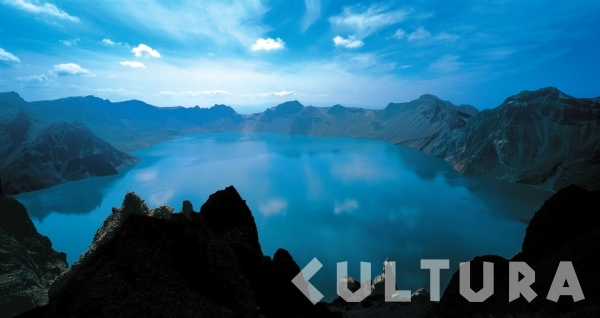
An aerial view of the northeastern tip of the Eurasian continent shows the Korean Peninsula bordering China and Russia and neighboring Japan across the sea to the east.
Korea is part of the Far East for countries in the West as it sits at the easternmost point of westerncentric maps of the past. Since Korea lies farthest east from Greenwich, United Kingdom, its clock runs ahead of GMT more than any other major country except for Australia and New Zealand.
The size of the Korean Peninsula is roughly equal to that of the United Kingdom. The land mass is mostly granite with mountains stretching out to the west forming plains alongside the slopes. Mountainous areas account for 70 percent of the land while the remaining 30 percent are plains and rice paddies. The highest mountain on the peninsula is Mount Baekdu, a name derived from how the top of the mountain is often seen capped with snow.
In the northernmost part of the peninsula bordering China and standing 2,744 meters tall, Baekdu is otherwise known as Changbaishan in China. At the southern end of the peninsula sits Jeju Island or Jeju-do which is landmarked by Mount Halla. Standing at 1,950 meters, the highest peak in the South, Halla was created by volcanic eruptions complete with crater lakes at the top.
Out to the east of the Korean Peninsula, a rocky yet remarkable island called Ulleungdo is wellknown for its picturesque seaside road selected as one of the 50 most beautiful places to visit in Korea by CNN Travel.
Even further east and annexed to Ulleungdo are a group of small islets including Dokdo. At the same time, off the opposite southwestern coast, Gageodo sits quite lonely in the Yellow Sea. Korea actually
has some 4,000 islands surrounding the peninsula, with the sea depth averaging 80 meters in the west and approximately 500 meters in the east. The sea at the south of the peninsula stretches out into the Pacific Ocean.
As part of the temperate climate zone, Korea enjoys four distinct seasons with its diverse terrain providing an excellent habitat for an extensive variety of animals including bears, foxes, deer, raccoons and wild boars. Tigers formerly lived in their natural habitat until the early twentieth century. Korea also takes pride in its diversity of plants with large numbers of botanical species. In addition, the variety of sea depths surrounding the peninsula provides an optimal environment for abundant stocks of fisheries. Thanks to such rich flora and fauna, Koreans can enjoy abundant food with diverse mixes of ingredients, creating a vibrant culinary culture.
For visitors coming to Seoul, temperatures climb as high as 35 degrees Celsius during summer, and it has been known to drop to as low as minus 20 degrees Celsius during winter.
Jeong Shik Kwak
Studied political science and business management. He began working in the steel sector in 1985. Apart from his stints at an international organization and a provincial government in Korea, he has been involved in global development of the steel industry for many years. Outside work, he has a strong interest in history and comparative studies of East-West philosophy and culture. Jeong Shik has previously published his research on 『the Global Scrap Market』 and an essay titled 『Survival and Self-esteem』.
* 《쿨투라》 2019년 2월호(통권 56호) *


